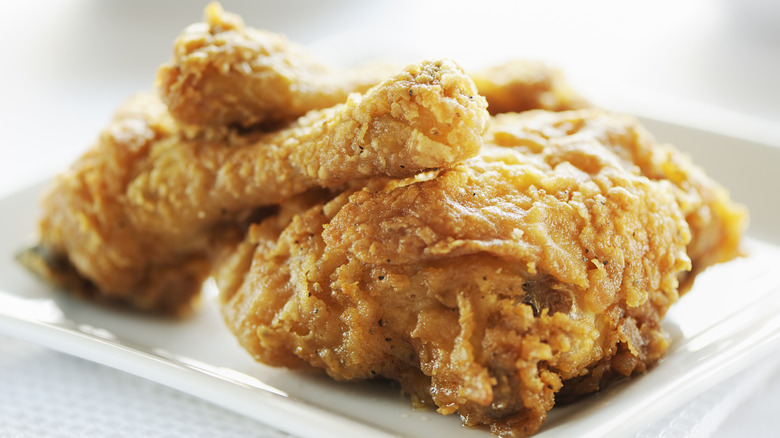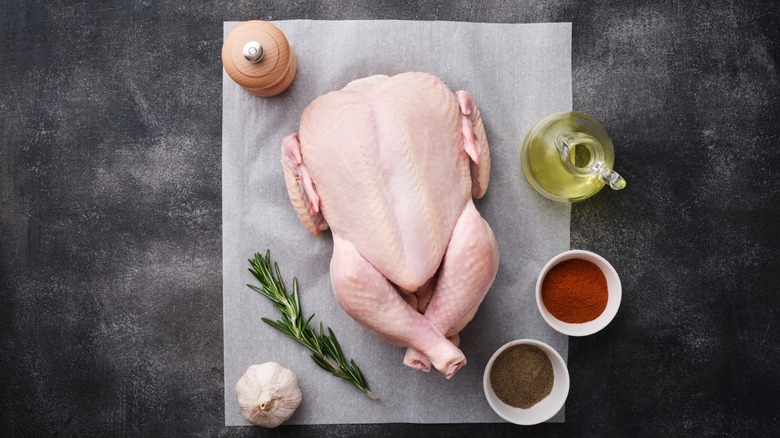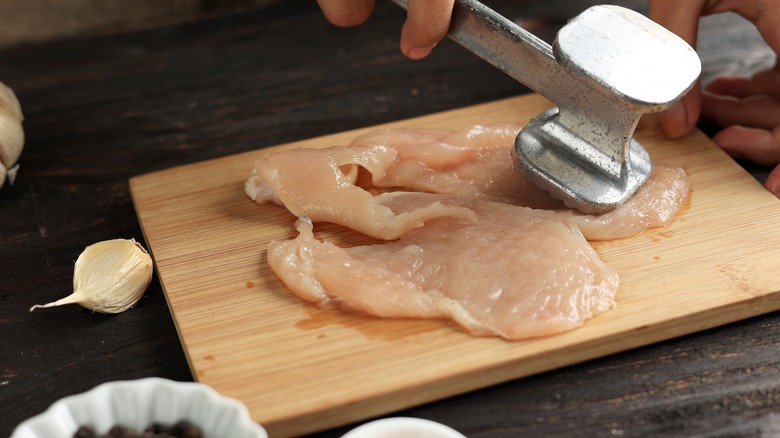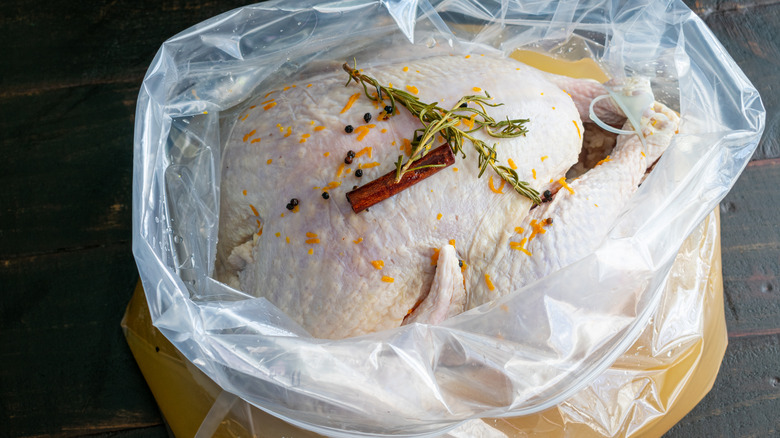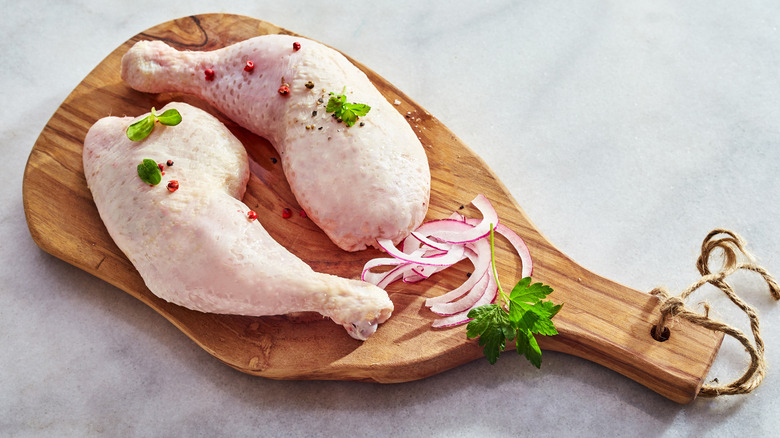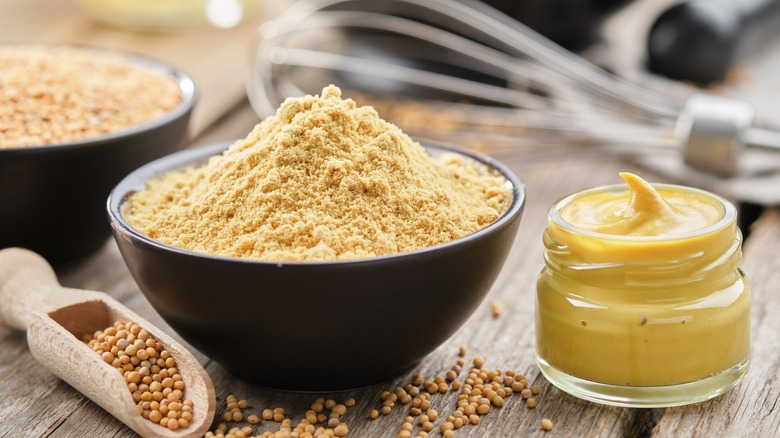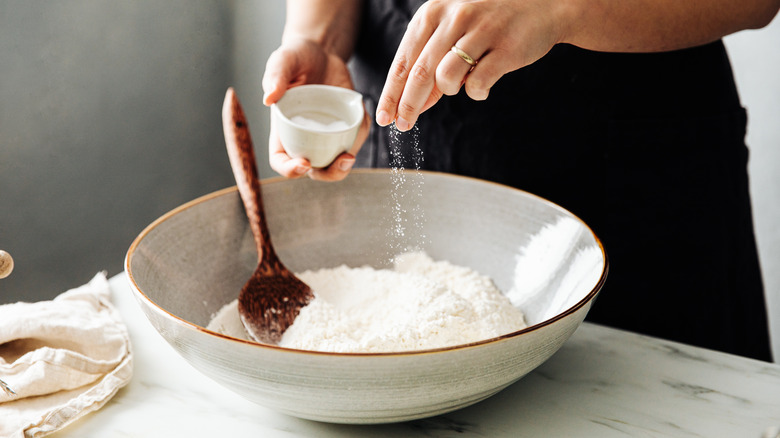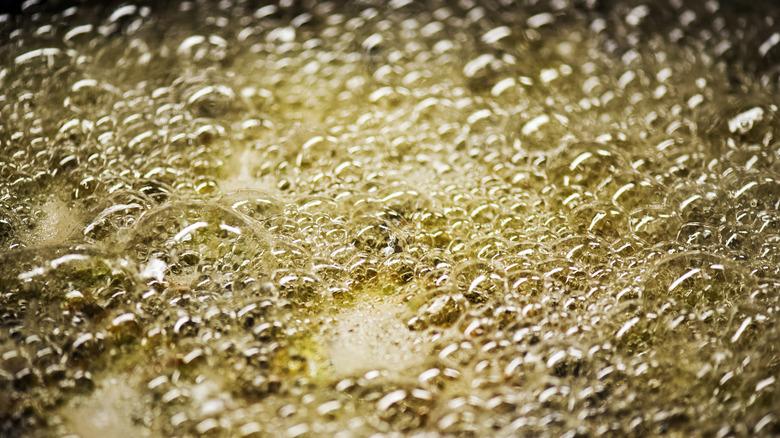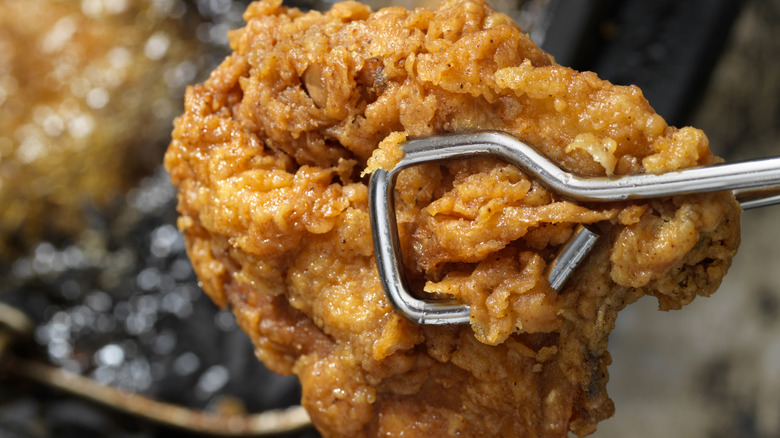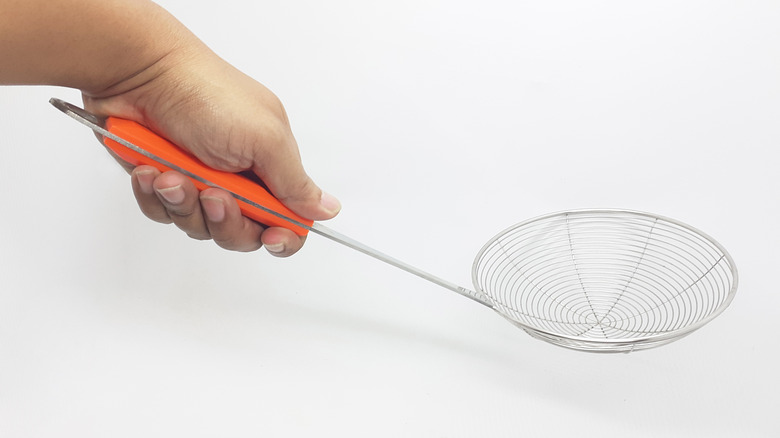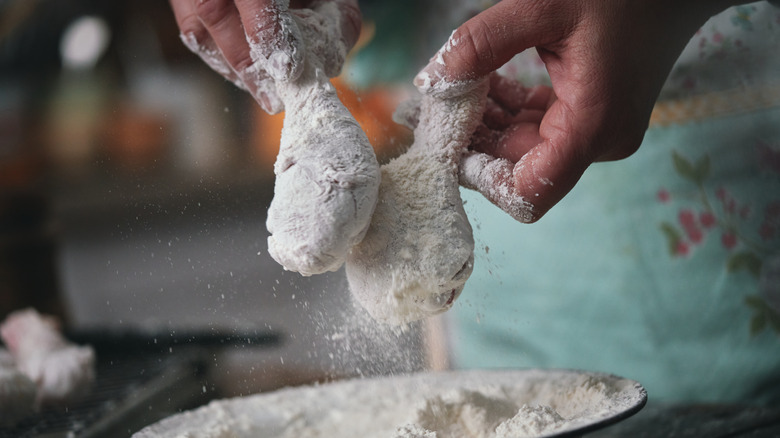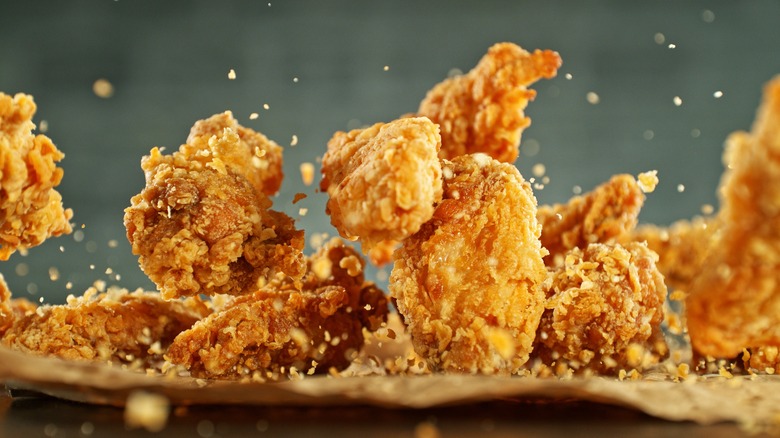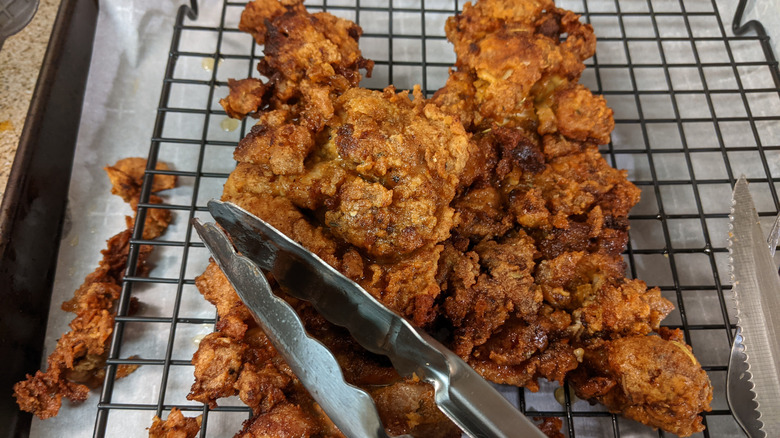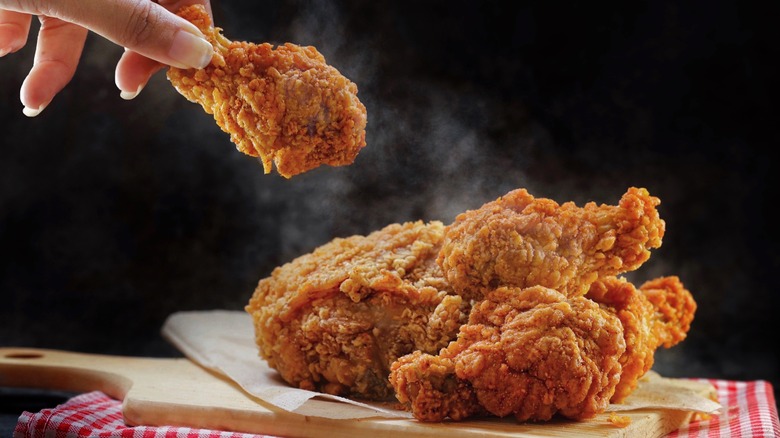13 Tips You Need For The Perfect Fried Chicken
Crunchy, crispy, decadent, and delicious, fried chicken is just at home on the menu at a 5-star restaurant as it is served up in a bucket and handed to you through a drive-thru window. It works on our plates at breakfast, flanked by waffles and smothered in syrup. It's perfectly pleasant on a plate with creamy mashed potatoes and tangy collard greens for a down-home dinner. It's an all-around good dish that can pretty much do no wrong.
Today's fried chicken can trace its roots back to the American South, where recipes from enslaved West Africans and those of Scottish and English descent came together to form the classic dish. If you're ready to tackle creating this iconic meal in your kitchen, you'll need to follow a few tips and tricks. From choosing the right cut (or cuts) of chicken to selecting the correct cooking oil, making fried chicken can be a home cook's first real foray into the world of deep frying and a salute to the chefs of the past who perfected the dish.
1. Choose a whole chicken and break it down yourself
Breasts or thighs? Dark meat or light? Wings or drumsticks? The question of what cut you need for the ultimate fried chicken home-cooked adventure is the first of perhaps many during your culinary endeavor. One of the absolute best cuts of chicken to deep fry is, arguably, chicken thighs. The dark meat stays juicy thanks to a high-fat ratio, plus a large surface area means you'll get plenty of crispy, crunchy breading.
But if you're looking for the most bang for your buck and a good mixture of dark and white meat, your best bet is to buy a whole chicken in the 2 to 3-pound range and break it down yourself. This will give you a bit of everything, but no pieces will be so big that they'll take ages to cook. Dark meat lovers will be happy with legs and thighs, while white meat devotees can dive into breasts and tenders.
2. Remember to tenderize
Once you've got your perfect chicken picked out, it's time to do a little prep work to ensure the bird inside that crispy coating is the absolute best it can be. There are plenty of reasons to tenderize your chicken before cooking it — whether you're braising, frying, sauteeing, or roasting. This especially goes for chicken breasts, so if you've bought an entire chicken, tenderizing is not a step you want to skip.
Tenderizing the chicken breasts can be done by sealing them in a plastic bag and then using a flat heavy object, like a cast iron pan, to pound the breast until it's an even (and thinner) thickness. Doing this, and doing it evenly all over your chicken piece, helps the chicken fry cook faster, more evenly, and stay super juicy and tender. If you were making something like a chicken Milanese or piccata, you'd want to go to a little less than an inch in thickness. But for something like fried chicken, aim for just slightly thinner than what you currently have. It's more about tenderness in this scenario than thinness.
3. Make a brine
Many recipes for fried chicken call for a brine or marinade ahead of time and the reason is to deliver the tenderest, juiciest fried chicken your taste buds have ever experienced. A brine is basically just a mixture of water, vinegar, salt, and aromatics to soak your chicken in before dredging and frying. The salt penetrates the chicken, seasoning it from the inside out and helping tenderize the meat itself. No flour dredge — no matter how seasoned and delicious — will do that.
There are hundreds of thousands of options for different fried chicken brines, with one of the most popular being pickle juice. Chik-Fil-A has long been lauded as having some of the juiciest fried chicken sandwiches thanks to its pickle brine-soaked white meat pieces. This pickle juice-brined fried chicken recipe makes use of both the salty dill pickle liquid and creamy yet acidic buttermilk. The result is a flavorful, extremely juicy, and tender piece of chicken, ready to be patted dry and placed in the fryer after it's dredged and ready.
4. Bring it to room temperature
As with most meats, chicken needs to be brought up to room temperature if you're going to create a fried chicken culinary masterpiece. If you were to try and cook a cold steak on a hot cast iron pan, you'd end up with a piece of meat that was overcooked and dried out on the outside and raw on the inside. In the same way, a cold piece of chicken thrown into a hot fryer will most likely be overcooked on the edges but raw in the middle. The breading will be overly crunchy — possibly even burned and acrid-tasting. Overall, it'll be kind of a fried chicken failure.
If you do let your chicken come to room temperature for about 30 minutes, the bird will cook faster and much more evenly. The inside will have time to cook thoroughly while remaining juicy, and the outside will have time to brown and crisp without overcooking. Don't leave raw chicken out for longer than an hour, as it can lead to bacteria growth. By the same token, never try to fry frozen or partially frozen chicken. The reaction between the frozen water and your hot oil could cause a serious burn hazard.
5. Add mustard to the mix
Salt, pepper, paprika, herbs like parsley, thyme, and even dill all seem very at home in a dredge for fried chicken. But you may be missing out on the one-two-punch offered by mustard either before or after your chicken has taken its hot oil bath. Fried chicken, by its very nature, is a rich dish, no matter which way you cut it (or cook it). Extra salt or pepper in its seasoning can help to lift and cut through the fattiness, but not in the same way that the sharpness of mustard can. You've likely added mustard powder to things like macaroni and cheese or basic bechamel sauces. It serves to sharpen the flavors of your other ingredients without overpowering your dish.
There are two ways to add the sharpness of mustard to your fried chicken. First, you can add a few pinches of mustard powder to your seasoned flour dredge. Second, you could take notes a la this mustard fried chicken recipe, and baste your raw, dried, and pre-buttermilk brined with bright yellow, classic mustard before dredging it in your seasoned flour mixture. You can mix it up, too, and use dijon, honey mustard, spicy brown, or even hot Chinese mustard, depending on the kind of flavor experience you're looking for.
6. Always season your flour
The Colonel uses 11 secret herbs and spices for KFC's famous fried chicken that, well, aren't that secret if you know how to Google. A quick search reveals that salt, thyme, basil, oregano, celery salt, black pepper, white pepper, mustard powder, paprika, garlic salt, and ground ginger are what make that fast food chicken so crispy and delightful. Adding these exact spices to your flour isn't imperative, but seasoning your flour in some capacity makes a big difference.
After your chicken has been tenderized, brined, patted dry, and come to room temperature, your seasoned flour dredge is the next step in the fried chicken adventure. Set up a breading station, and dip your chicken in an egg wash before dipping it into your seasoned flour mixture. It can be as simple as salt and pepper, or as fancy as the Colonel's mixture. Chef Sean Brock adds yellow cornmeal to his dredge for extra crunch. Really, the seasoning is up to you and your taste. Also, make sure you're not over-coating your chicken. Too much flour can result in a greasy, limp crust — the opposite of what you're aiming for.
7. Choose the right temperature for frying
The chicken is dredged and you're ready to fry! Frying may seem deceptively simple, but there are quite a few rules and best practices before you lower your chicken into its golden, oily bath. First and foremost, grab yourself a high-sided cast iron skillet or a Dutch oven for your frying. You don't need to fill it with oil, either — you just need enough to coat the sides halfway and then be ready to flip. As far as the oil in your pot, you'll want to steer clear of oils with low smoke points like olive oil. Instead, reach for options like sesame oil, canola oil, and even peanut oil — all of which have high smoke points, meaning the point where the oil starts to break down.
The temperature of your oil is perhaps the most important piece at play here. The best oil temperature for creating perfect fried chicken is going to be between 300 and 325 F. Use an oil thermometer to make sure you're in the right ballpark and don't rush it. As soon as you start dropping your chicken pieces, the temperature of the oil will lower, so be ready to adjust as needed to ensure an even cook. You want your oil hot enough to cook the raw chicken, but not so hot that it burns your crispy coating.
8. Fry skin side down
While you're standing over your pot of molten oil, trying not to have an anxiety attack about getting splashed, you'll need to keep an eye on how your chicken pieces are situated in their hot tub. Many home cooks and professionals alike swear by frying their chicken skin side down, as opposed to just dropping them however they see fit. The side of the chicken that hits the hot oil first will always be the better-looking side. This helps the fattier side render and will help stave off any notions of flabby or gummy chicken skin. When small bubbles begin to appear on the uncooked side, it's time to flip the chicken over.
It is important — as with most cooking and frying — to not mess with the chicken too much while it fries. Doing so could lose some of your breading or cause the chicken not to cook correctly.
9. Use a spider
Tools of the trade when it comes to frying chicken are minimal, but important. As we stated earlier, a good, high-sided cast iron pan is your go-to vehicle for the frying itself. Two or three cake pans are always the best for your breading stations — one for flour, one for egg, and one for finished and dredged chicken. And, when it comes to making moves (minimal ones) while you're actually frying, a spider is your best friend.
If you've never used or heard of a spider in the kitchen, rest assured it isn't an actual spider sent to direct you Ratatouille-style. A spider is a kitchen gadget that looks like a wide strainer made of metal or mesh attached to a big stick. It's frequently used for frying and poaching as the basket is gentle with your freshly fried or poached goods and the long handle ensures you won't be getting burned. Also, excess oil drips through its ridges, which means your chicken won't be sitting or covered in an extra heap of hot grease.
10. Don't overcrowd while frying
In your cast iron skillet, where fry magic is taking place, it's important to give all of your chicken pieces their space. Once your oil is up around its premium cooking temperature you'll begin adding pieces of dredged and seasoned chicken. Even at room temperature, though, obviously said chicken is a lot cooler than the 300 F oil bubbling away. So, each piece is going to bring down your oil temperature, and you'll have to keep a close eye on getting the oil back up to its premium temperature to ensure crispy, perfect chicken.
It goes without saying, then, that the more chicken you add, the more the temperature is going to drop. The general rule of thumb with frying chicken or, really, anything, is to cook in batches. Add maybe two or three pieces of chicken at a time, flip them, and remove before adding more. It may take a bit longer, but the alternative is having chicken that isn't properly crispy or potentially even cooked.
11. Double fry your chicken
Fried chicken is so nice, you should fry it twice. In all seriousness, though, double-frying is something to consider when cooking up a batch of this decadent treat. Like French frites, which are double-fried french fries for the uninitiated, double-frying your chicken can help you achieve the crunchy, crispy exterior you're looking for without overcooking the meat within. Even with brining and tenderizing, leaving your chicken pieces in hot oil long enough to get that good, crispy crust could result in a drier-than-you'd-like bite.
The best way to double fry your chicken is to initially fry your chicken until it's cooked and looks golden brown. Pull it out, then let it rest at room temperature for a good 30 minutes. Longer is okay, too, as is putting the chicken in the refrigerator. Then, when your oil is ready again, fry your chicken a second time. There's no re-seasoning or re-flouring involved; you're quite literally just frying your chicken again. The colder interior is less likely to overcook or lose juiciness, but the outside will take on additional crispiness.
12. Drain and rest it
As with most fried items, after your chicken pieces have been removed from the frying oil, you'll want to drain and rest them. Normally, you'd likely reach for a paper towel-lined plate to allow the excess grease to drip off of your chicken before it hits a plate. This is a pretty serious mistake when draining fried chicken. Doing so can cause your chicken pieces to steam since they've just come out of the hot oil. Steamed fried chicken means your crispy skin is going to become more limp and soggy, losing that crispy bite.
There are a few ways around this while still ensuring your fried chicken pieces aren't doused in fryer grease. First, you can crumple paper towels on top of a wire rack or cookie sheet, then lay your fresh-out-the-oil chicken pieces on top. Since they aren't laying flat, the chicken won't steam (air can get up and around that crispy skin), and the grease can still drip off each piece. A second way you can avoid steaming chicken on flat paper towels is to line a cookie sheet with paper towels and then place a lifted wire rack on top. The rack allows the chicken to drip onto the towels, saving you a bit of mess, while also allowing air to flow around the chicken.
13. Season once it's out of the fryer, too
As a final and, arguably, crucial step in your fried chicken escapade, don't forget to season one final time. As soon as your chicken exits the oil and has been placed on a wire rack or crumpled paper towels to cool, you have the opportunity to sprinkle it with any combination — classic or complex — of herbs, spices, or seasonings you want. The fresh oil and grease will help whatever you do add stick, so you can rest assured it won't just brush off as soon as you serve up your chicken.
There are plenty of ingredients, seasonings, and herbs you can (and should) be adding to your fried chicken, but among the top tier are salt and freshly ground pepper. It'll give your chicken that final kiss of classic seasoning that it could need. You can also sprinkle over fresh herbs like thyme (arguably chicken's best herb friend) or chopped parsley for a fresh kick. Other options include lemon zest or even a spritz of lemon juice or a touch of chili oil.
